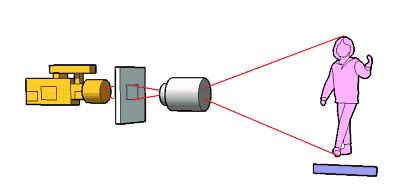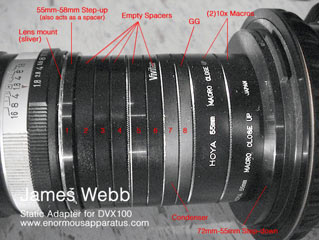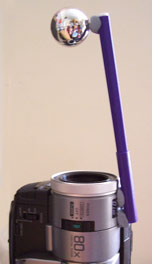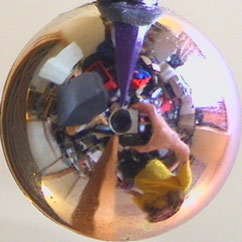THE SHOOTING GALLERY: NEW HIGH-END DIGITAL CAMERAS
John Coghill - Dalsa
Franz Kraus - Arriflex
Jeff Kreines - Kinetta
Nolan Murdock, Panavision
David Stump, ASC, Moderator
David - film & digital are collaborating rather than fighting
3 chip prism based vs. 1 chip new camera
35mm lenses on HD cameras, depth of field & image quality
4:4:4 color space
film style accessories
talk about workflow, all the way to filmout- the WHOLE workflow
What makes these cameras so special?
John/Dalsa - 4K
workflow is the new mantra, a lot of intricacies to workflow, for cinematographers, they are worried that creative intent flows all the way through the process; Below The Line has an article on "DPs want pay for DI duty" - 2 things mentioned - Daviau said he couldn't have made Van Helsing w/out DI, Bob Richardson/Tarantino fight over control over Kill Bill.
how to will cameras ensure intent is carried through?
-metadata
-SMPTE .dpx - 4K 16 bit"format for the exchange of digital moving pictures ona variety of media between comptuer based system"
-flexible res indie, attributes in file header
-individual 16 bit files DPX inside folders, script supervisor info builit into that, each scene/shot/take recorded as a folder
-onset CDL (color decision list), look manamgement system can be embedded in file header
-render a full res "wedge" that can be embedded inthe CDL to be included inthe file header to make some basic decisions on set to go with the data
-when agreement is reached on a format it will be a siimple matter to implement within the .dpx header
"committees make progress one funeral at a time"
WHERE'S ROOM FOR IMPROVEMENT FOR 35MM LIKE CQUALITY
Usability:
-compatibility with existing accessories, 35mm lenses, backfocus range, single chip, large format sensor
-optical viewing system with rotating mirror, SOA (safe operating area)
-simple user menus, not too many menu layers deep
-record via fiber up to2 2Km (cranes, remote spots w/limited space)
-records to drives
-bidirectional communication to send images to set
Image Quality:
-optical input - lots of exposure lattitude, spatial res, and "fill factor" are key (a catchall for how much of the surface area of the chip is capable of converting image into picture - minimal gutters?)
-they make their own sensors, their own chipsets
-conversion from analog to digital can't compromise images, highest bandwidth pipeline possible maintained - no video formatting
-record "digital negative" - no pre-baked decisions, you record 16 bit linear raw files, maximum room to mess with it
-good source to archiving
Workflow compatibility:
-capture to drives with digital neg quality
"DALSA Certified Post House" - (scary!)
-data centric approach enables compatibility with multiple formats and tools
-they have a 4K pipeline on their site for stuff to play with
-full screening room w/2K projector
-plan is to work w/post facilities to test facilities and certify the process, continuity of metadata etc.
-metadata - ensures elements don't get "lost" between multiple sights
-enables easy editing, conforms, synch sound etc.
-single source master philosophy
-dpx already supports film & TV formats - (film mfg & type, shutter angle, frame rate, etc. etc. etc.
Conclusion:
role of camera manufacturer changing:
-must take a system perspective
-must enable more than just great images
-must be compatible with familiar tools
-must integrate into the whole workflow
SHOWING DALSA SAMPLE FOOTAGE:
shots holds sky/clouds detail and mountain shadow detail
interiors seeing outside
seeing 12 stops of exposure lattitude, a couple more on the top end, 14 stops total
shot some night stuff, they couldn't get spot meter readings, saw detail on footage
JEFF KREINES, KINETTA
========================
-camera is designed for nonfiction and indie filmmakers, self contained recordeer
480 GB storage
records to "paranoid RAID", 12 drives, 10 drives primary, 1 RAID 3 parity, 1 hot spare
magazine in camera attach by bidirectional fiber link, can separate by a coupla kilometers, a single 6mm cable (3mm fiber optic inside)
-record 12 channels of 12 bit 96Khz audio, 4 analog, 8 digital
-workflow:
many different ways to go, store data in raw format, raw single sensor output like a digital still camera, get a 3:1 savings in storage space, don't do demosaic at time of capture
-data all stored raw w/metadata
-working w/Iridas speedgrade for Kinettta
USB cable into ccamera, load in up to 3D nondestructive LUTs, dual link HD-SDI, DVI LUTs for lots of stuff, looks recorded as metadata,
-don't ever mess w/your digital neg
-how do you store it inexpensively
-looked at HDCAM SR and nixed it, $100/hr, $100K deck
-two different options to store - using LTO3 tapes, uncompressed 400GB tapes, $100 each, 7 tape autoloader for $6 or %7K
-clones a mag to roughly realtime for almost 2 hours of stuff
-magazines are about 1 hour for 480 GB
-they also make a box that'll let you dump to a set of 6 drives
-one new exciting feature - new dynamic range expansion feature - camera is designed to be sensor agnostic, using Altasens at the moment, can run for hours on one battery (low power draw)
OLED viewfinder can be up to 10 feet away
-4 user definable buttons on the viewfinder
-camera designed to handle any sensor up to 16 megapixels, you'd need more than one magazine to record 4K
-concurrent photon amplification for dynamic range expansion - it takes 6 photons to make "real" data - if you add a little bit of light to that, or use more aggressively to reduce contrast
-have an integrating chamber, have RGB LEDs to boost around the sensor, all done optically around the sensor
-852x600 for viewfinder
-workflow: with Iridas, can make LUTs stored in camera, can plug laptop in via USB into a magazine, feed to monitor, can create new LUTs for every shot on the drive - can do a post shoot color grade onto the file header, can have multiple LUTs, do it into your hotel room
-workflow for smaller crews
-beauty of what they're doing serves different sets of users, not in competition
-JEFF STILL ISN'T SHOWING ANY SAMPLE FOOTAGE!!! DAMMIT!
Q: memory requirements for 100 minute of footage:
Nolan, Panavision guy:
don't limit yourself during acquisition is a lesson learned - don't limit to TV color space
"do no harm" during original acquisition
-they do ship more diffusion filters than lenses
-"the film camera that shoots tape" it was dubbed for the Genesis
Genesis uses all their standard cinema accessories
Millenium XL is about same size as their smallest/lightest camera, same weight about too
-super 35mm sized sensor
12 megapixel true RGB, no Bayer
1 to 50 fps
nominal exposure 400
dual link HD-SDI out
14 bit A/D
dockable VTR (no cables)
-10 bit log color
-custom gamma curve for extending overexposure lattitude
-wide color gamut for film intercut applications
-can load LUTs into the viewfinder to see what it would look like
-lens lateral color compensation
-can correct that lens on the fly and record an image without lateral chroma for pulling better mattes on green/bluescreen
-uses spherical lenses, will have anamorphic at CineGear
-they use a macrocell - a 6 pixel thing - RGB over RGB, 3x2 grid to make colors, these add up to make a pixel, like a Trinitron
Workflow:
-dual link HD-SDI 10 bit log, custom gamma curve
-raw image is flat and low contrast
-custom display boxes allow, can load LUTs made in PShop (nice!)
-can record all kinds of metadata
-provide to post facilities appropriate gray box and color cube for calibration
-load a LUT into a "preview box" to preview that way, without touching the raw source
Editorial opportunties:
on set downconvert to NTSC or PAL
-networked device with removable drive packs
-synced oaudio and time code
-listens for Genesis to go into record, it goe sinto record
-writes native Avid files
-collects scene and take info from other networked device, adds metadata
-remove disk packs, mount as Avid drives, cutting in minutes
WHAT ABOUT FINAL CUT PRO INTEGRATION?
Off speed tests done, showing in booth, check it out in Sony booth
ARRIFLEX GUY:
D-20 workflow technology
showed footage - looks like video, candle flames a bit sharp - the color is rich, and has very good color detail - come see their booth for more footage
goals of test:
-test in realworld environment, got some good screening material, proof of operational practice & workflow, got good feedback
D-20 modular design:
PL mount, optical viewfinder, mirror shutter,
-silent mirrored shutter
-camera control electronics down where they are expected
-wanted look & feel of operating traditional film camera
-CMOS image sensor, custom developed
-35mm format CMOS, ARRI custom development
-sensor can do 150fps, NOT accomodated in camera
-2880x2160
bayer mask
400 ISO equivalent
at least 10 f stops
on lattitude - most folks don't use film as rated, they are curious to see real world usage
-has three output boards - (they use metadata for digital and film related), so much intent gets lost with distributed production, wanted to fit into existing workflows. Have 3 different cards and electronic processes for different lookup tables, camera runs up to 60 fps, need dual link for that, log data stream for post, separate HD-SDI for monitoring, and an SD output for
HD and raw modes
alias free 1920-0x1080 @ 4:2:2 and 4:4:4 HD
LUT options including log/lin
variable speed - 1 to 60 fps (how to record/flag/extract?)
by using 3Kx2K that allows for an alias free HD
WORKFLOW:
shoot, conform/grading feeds all others
if film out, need a color management system to filmout
DI log workflow, need LUTs for video and projector outputs
4K digital cinema - they can't do it yet on their current imager (implies others can't as well)
If you pull a 2K out of the 4K
shows some image extraction if you pull subsections - zooming in
film offers res>2K, exposure lattitude>12 stops, archival advantages, high frame rates w/resolution, high quality, efficient film/DI stuff, worldwide workflow known
D-20: immediacy, no grain, no scratches/dirt/dust, no weave, cost of high shooting ratio
digital will complement, not replace film
DI provides a common platfor for material acquired on film & digitally
Q&A:
----
cost of media to store 100 minutes of footage:
400GB for 100 minutes for Kreines
TB/HR for Dalsa
D-20 size - HD as done now, so run the math there...
Nolan - same for his as well
Kreines said - Digital Cinema is a long way off for now...filmouts are going to be relevant for quite some time, against using dupe stocks for digitally originated stuff, use 5205 for affordable film stocks, make multiple original negatives rather than dupes, can take raw files, got into Iridas, work on timeline, go to film recorder
D-20 panel ready to run again:
AHH! some nice depth of field digital wouldn't do, good shadow detail video would never get, closeups of candles - OK, couldn't do vidoe for that well, outdoor stuff - Hmm...hI'm not loving it for some reason - maybe projection issues?
TAKEAWAY - image quality is pretty good, but film continues to sound better and better...costs of overall stuff! Kreines made no comment on image quality or cost or availability (later said looks like fall or 6 months from now). Somebody who's worked extensively with the Viper said that they were very underwhelmed with the Genesis after all the hype about it.
-mike











































 I've seen lots of circuit bent musical instruments, but this is the first piece of video gear I've seen get bent. Waterhed modifies old Fisher Price PXL-2000 cameras in order to give them RCA outputs and some built in "effects".
I've seen lots of circuit bent musical instruments, but this is the first piece of video gear I've seen get bent. Waterhed modifies old Fisher Price PXL-2000 cameras in order to give them RCA outputs and some built in "effects".

